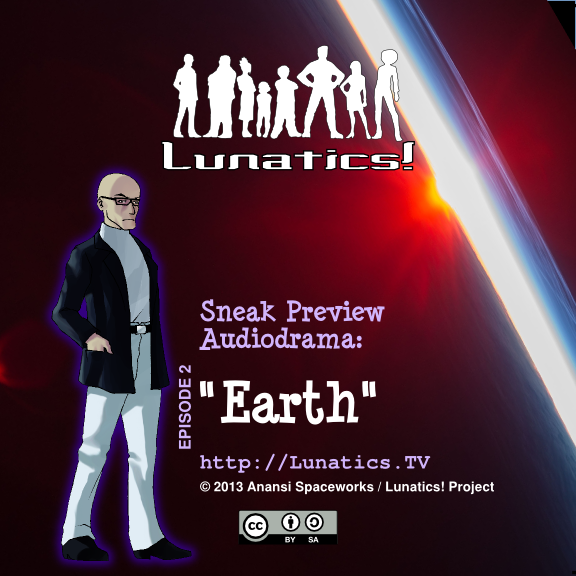I’m currently doing the sound-design for the Audio Drama: picking music tracks from the track library, trying to figure out what ambience and sound effects to use, and moving the voices into scenes.
I spent some time last night listening to other audio dramas — “The Hitchhiker’s Guide to the Galaxy” (man, that’s intimidating!), “The War of the Worlds” (the 1938 radio show), BBC’s “The Lord of the Rings” full cast production, and a bit of ZBS’s “Stars and Stuff”. All quite different (that being the point of these selections). These are all excellent audio productions, though they vary a lot in their sound design choices. “The War of the Worlds” was very limited according to the radio technology of the day (not nearly as much dynamic range or frequency response as we have to work with nowadays). “Hitchhiker’s” of course, is just stunning — probably the best audio production ever, in my opinion.
I’m pretty sure I know where I want to go with this now.
Workflow with Audacity
For those who are curious, let me outline how our sound production workflow works.
Of course, we start with a script. We had conference call in September 2012 with the principal actors, and we did a read through of both “No Children in Space” and “Earth” (“Earth” is what I’m working on now). This allowed us to clear up some basics about the lines, and then the actors could record takes of the lines to send to me (by various means, as it happens — we do have a special upload tool for this, but some of them were just email attachments).
I then opened up whatever they gave me and did some minimal processing in Audacity, moving all of the lines into clusters of takes for each line for each character. I then exported this as a lossless FLAC audio file — one for each character role in the episode. This is what I have included in the source tree as the actors’ input lines — this way, they’re all consistent.
I then make an Audacity file for the episode’s dialog. One-by-one, I import each character’s voice takes into the file. First, I have to “gap” the audio — I use “Split Delete” to delete the silences between the takes (I wish there were a way to automate this step, but Audacity doesn’t seem to recognize the silences — it could be they’re not perfectly silent or something, though in some cases, that seems surprising). This gets a bunch of individual snippets of dialog, which can then be moved around. I give these tracks a name like “~ALLEN”, which means it’s the “source” track, which will wind up with all of the outtakes.
I then go through the process of selecting takes. I think this is probably the hardest part of the project, because it involves listening to the same takes over and over again, and making lots of little decisions. Sometimes it’s quite hard to tell them apart. And sometimes, the best take will depend on the takes selected for the other characters. Choosing which character to introduce first is tricky too — I usually try to work by selecting the character with the most lines first, and then building around the primary conversations that character is involved in. In Earth, for example, there are important dialogs between “Allen” and “Anya”, between “Allen and Georgiana”, and also between “Rob”, “Josh”, and “Anya” — “Hiromi” and “Tim” have fewer lines in this episode, so they were added last.
As I select takes, I move the one I select in a new track just named after the character, like “ALLEN”. These are the live tracks for the episode. I space these out into scenes, and as I add new characters, adjust the spacing to create the dialogs. I mute the “~” source tracks (I picked “~”, BTW, because if you do an alphabetical sort on the tracks by name, they will all fall to the end. I also add a “*LABELS” track with labels identifying each scene by name to keep a rough track of where everything is).
Eventually, I have the dialog for the entire episode as a series of scene dialogs, with gaps in between. For testing, I export these to MP3, import the resulting file in Audacity again, delete the gaps between the scenes and re-export as an MP3. This produces a rough version of just the unadorned, mostly-unfiltered dialog, so I can hear how it’s working. After going through all of this, it’s not unexpected to find that some lines just don’t quite work.
So for those, I go back to the actors and ask for a few “pick-ups” (we’re doing a few of those now — normally it’d be good to do this on a shorter timescale. It is a little worrying that we’ve had a year between principal recording and pick-ups on this production (shorter for Ariel, fortunately — she did the main recording for Georgiana just a couple of months ago. Of course, her voice is gradually changing).
After this, I then need to break the episode up into scenes. I do this by opening the original dialog file, deleting all the extra stuff and then saving under a new name for each scene. This is the only way I know to preserve all of the Audacity project structure for each scene.
I also spend some time selecting music, figuring out what sound effects and ambient sounds I need, as well as what kind of filtering, panning, and other effects I want to do on the voices. I also plan out how I want the sound levels to work out — conversation level, ambient sound level, background music level, and peak sound levels.
Now that I’ve got things chopped down to more manageable chunks, I can start to add the music, sound effects, ambient sound, and foley sound. I can also get finer control over the level of each individual line, so I can get them to be more balanced with each other.
This is the phase I’m working on now with “Earth”.
So far, I’ve been doing all of this with Audacity, and it seems to be a good choice. An argument could be made that I really ought to be using a more complex audio editor like Ardour, and maybe someday I will try to learn that. But so far, Audacity seems to be doing the trick.
“Earth” as an Audio Drama
Of course, “Earth” was really intended to be an animated video, rather than just audio, so there are some adjustments that have to be made. We are adding just a tiny bit of narration, and a few of the “pickups” are actually re-written or added lines to make up for the lack of visual cues. In an animation, we can show that someone is present without them having to say anything, but in an audio play, we need them to say something just so we can identify them.
“Earth” requires surprisingly little change to work as an audio drama, which is the main reason we chose it for this project.
It does take some getting used to. Sound design for an audio production is very different. It’s often necessary to emphasize speech and use less music than you would for video, which may seem a little counter-intuitive. But it seems to be true — without something to look at, music can get a little dull, so the musical elements are usually shorter. And of course, credits have to be spoken, so there’s only going to be a little bit of the title music in this version.
Of course, I’m still going to want to make the animated version of “Earth” — there’s a lot of visual stuff I want to be able to add. But I think it’s going to be a lot easier to find people interested in supporting that if we’ve got a finished story out there for people to enjoy. Of course, we may find that an audio drama is really what people would prefer. Not sure what I’ll do if we get that reaction. Probably go ahead with the animation anyway, since that’s what we wanted to do.
FenCon X
We’re planning to get the Audio Drama finished and online by October. We’ve been given the opportunity to give out freebies to the “Friends of the Fen” premium memberships for FenCon X [CURRENT], which is an annual science-fiction convention in Dallas. They’ll get cards with a link to the download site (also a QR code for those who prefer not to type). Perhaps we can get a little exposure for “Lunatics!” that way.
If you know of a local convention that might also like to get cards like these, let me know (at digitante at gmail dot com), and I’ll see if I can’t arrange to send them something as well. I was really hoping to send some pressed CDs, but we didn’t have the turnaround time (or the money) to do that.
One nice thing about sending them cards instead of CDs is that we actually have right up until the conference (starts on Oct 4) to get our audio final and complete and uploaded. I would actually have already had to send the audio to the CD press by now to have physical CDs in hand for the con.



